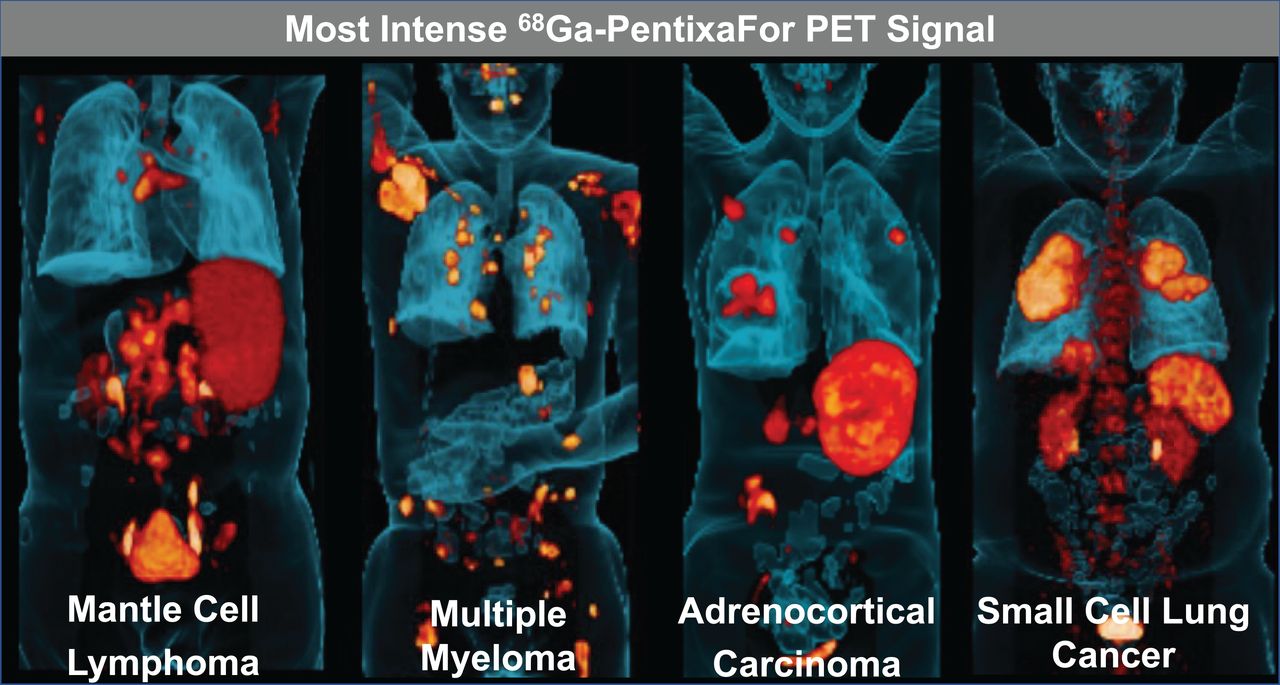一种新的分子成像放射性示踪剂可以精确诊断各种癌症,为识别可能受益于靶向放射性核素治疗的患者提供了路线图。在此类规模最大的医学研究中,研究人员发现68Ga-PentixaFor在血液恶性肿瘤、小细胞肺癌和肾上腺皮质肿瘤中表现出高图像对比度。这项研究发表在《核医学杂志》11月刊上。
显像剂68Ga-PentixaFor用于检测C-X-C基序趋化因子受体4 (CXCR4)。趋化因子受体表达是癌症患者预后不良的预测因子,因为它促进恶性细胞的生长并抑制抗肿瘤反应。
德国维尔茨堡大学医院核医学科主任Andreas Buck说:“了解哪些癌症增加了CXCR4表达,可以显著影响临床肿瘤分期,并随后影响患者管理和治疗决定。68Ga-PentixaFor PET特别令人感兴趣,因为它比其他成像方式(如MRI、CT甚至FDG PET)提供了更高的病变检出率。”
在这项研究中,研究人员评估了68Ga-pentixaf的摄取和图像对比度,以确定CXCR4导向成像的最相关的临床应用。两个研究地点对患有35种不同类型癌症的690名患者进行了68Ga-PentixaFor PET。解释图像并进行统计分析。
在多发性骨髓瘤、肾上腺皮质癌、套细胞淋巴瘤、肾上腺皮质腺瘤和小细胞肺癌患者中发现非常高的示踪剂摄取。记录了图像对比度的可比结果。
Buck说:“这些结果表明,68Ga-PentixaFor PET可能有利于指导CXCR4靶向治疗的临床方案。这对于缺乏更合适的成像方式的恶性肿瘤尤其重要。一项关键的三期研究计划在2023年第二季度继续。”

图形摘要:PET信号最强的68Ga-pentixaf。
The authors of “Imaging of C-X-C Motif Chemokine Receptor 4 Expression in 690 Patients with Solid or Hematologic Neoplasms using 68Ga-PentixaFor PET” include Andreas K. Buck, Niklas Dreher, Alessandro Lambertini, Andreas Schirbel, Samuel Samnick, and Sebastian E. Serfling, Department of Nuclear Medicine, University Hospital Würzburg, Germany; Alexander Haug and Marcus Hacker, Division of Nuclear Medicine, Medical University of Vienna, Vienna, Austria; Takahiro Higuchi, Department of Nuclear Medicine, University Hospital Würzburg, Germany, and Okayama University Graduate School of Medicine, Dentistry and Pharmaceutical Sciences, Okayama, Japan; Constantin Lapa, Nuclear Medicine, Medical Faculty, University of Augsburg, Germany; Alexander Weich, Department of Internal Medicine II, Gastroenterology and ENETS Center for Excellence, University Hospital Würzburg, Germany; Martin G. Pomper, The Russell H. Morgan Department of Radiology and Radiological Sciences, Johns Hopkins School of Medicine, Baltimore, Maryland; Hans-Jürgen Wester, Pharmaceutical Radiochemistry, Technische Universität München, Germany; Anja Zehnder, Department of Nuclear Medicine, University Hospital Würzburg, Germany, and Pentixapharm Würzburg, Würzburg, Germany; Verena Pichler, Division of Pharmaceutical Chemistry, Medical University of Vienna, Vienna, Austria; Stefanie Hahner and Martin Fassnacht, Division of Endocrinology ad Diabetes, Department of Medicine I, University Hospital Würzburg, Würzburg, Germany; Hermann Einsele, Department of Internal Medicine II, Hematology and Oncology, University Hospital Würzburg, Würzburg, Germany; and Rudolf A. Werner, Department of Nuclear Medicine, University Hospital Würzburg, Germany, and The Russell H. Morgan Department of Radiology and Radiological Sciences, Johns Hopkins School of Medicine, Baltimore, Maryland.
